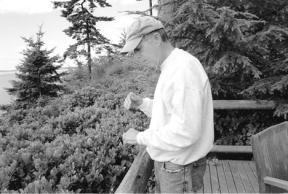Greenbank residents know Lake Hancock is a breeding ground for mosquitoes. But knowing and being able to do something about it are two different issues.
Lake Hancock, just north of the Greenbank Farm, and the surrounding 28-acre saltwater marsh, is a breeding ground for at least six known species of mosquitoes.
The property is under the control of the Navy and the Nature Conservancy.
One of the species that calls this swampy place home, the Aedes dorsalis, is a real nuisance to humans, although it is not known to carry the West Nile Virus. The Navy is taking no steps to curb the mosquito population because of regulations forbidding the use of insecticides near salmon breeding grounds, such as those in shoreline areas like Lake Hancock.
Smugglers Cove residents, Wade and Osa Sommermeyer have been kept inside for most of the summer because of the numbers of this particularly aggressive mosquito.
Standing on the bluff overlooking Saratoga Passage or in the couple’s organic vegetable garden, Kamikaze-like Aedes dorsalis mosquitoes buzz around before landing on and biting any exposed skin.
Sommermeyer, a retied airline pilot said he could have retired anywhere, but he and his wife chose this five-acre site to build their home in 1998.
While standing on small deck on the bluff overlooking Saratoga Passage Sommermeyer said, “We love it here.”
However, the mosquitoes are another issue.
“But put yourself in our shoes, how would you feel if you had to live indoors during the summer months,” Sommermeyer said. “I am particularly concerned about my wife, because she is allergic to mosquitoes. One bite and her hand will swell up.”
The Sommermeyers do use an organic mosquito repellant, “but it means cleaning up every time you go into the house for a break or lunch.”
The Sommermeyers are not suffering alone.
The Navy’s environmental health officer, Lt. Matt Sullivan, has been getting a number of calls of calls complaining about the mosquitoes.
In response to the complaints, the Navy conducted a study of Lake Hancocks’s mosquito population beginning in May through September 1998. Though Navy surveyors did not find many of the mosquitoes that carry West Nile, they did find a lot of Aedes dorsalis, a particularly aggressive mosquito able to fly distances several miles.
“They are persistent biters attacking both during the day and night,” Sullivan said.
The Sommermeyers are still concerned about health risks, despite the Navy’s assurances.
“They say the Aedes dorsalis doesn’t carry West Nile, but how do they know for sure,” Sommermeyer queried.
The other species found during the study include Aedes campestris, Aedes punctor, Culex restuans, Culiseta impatiens and Culiseta inormata. Two of them are known to carry the West Nile Virus.
Even with these insects present and after taking plenty of complaint calls, the Navy has not undertaken a mosquito control program. The Navy’s own study recommended that a control program be started “only if a disease threat develops or at the request of an outside government agency,” according to Sullivan.
The study also reported that the disease threat in 1998 was low, but that conditions can change over time and can be influenced by poor sanitation following disasters.
Until the Navy decides to do something about the mosquitoes, Sommermeyer knows from mid-July ’til September his yard has been unfit for human use.
Sullivan is sympathetic with nearby residents like Sommermeyer, but admits his “hands are tied.
“There is a ban on the use of pesticides along salmon bearing waterways,” Sullivan said.


